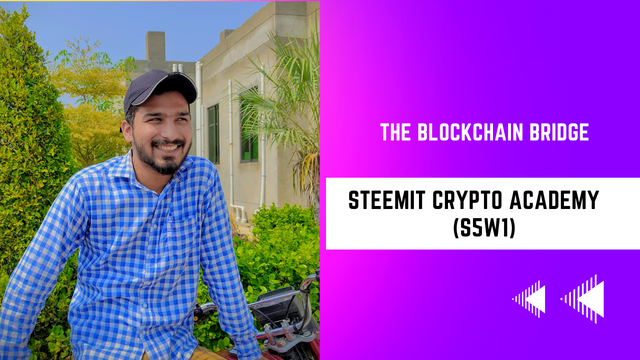
BLOCKCHAIN BRIDGE AND ITS NEED IN BLOCKCHAIN
Users can transfer cryptocurrency between two blockchains because of a bridge that connects them. Basically, you can use the bridge to spend BTC crypto-coin like Ethereum (ETH) if you have it. Blockchain's inability to collaborate was one of its main problems. Each blockchain, while flexible and relatively efficient as stand-alone entities, is limited by its own domain boundaries.

Often, this can result in costly transactions and congestion. This problem is solved by blockchain bridges, which allow the transfer of crypto tokens, data exchange and smart contracts, as well as other feedback and instructions between two separate platforms.
This bridge acts as a neutral zone so that users can easily transition between the various coin technology processes and operational paradigms of these blockchains. For the majority of us, access to multiple blockchains through the same network dramatically improves the cryptocurrency experience.
ITS NEED IN BLOCKCHAINS
Each blockchain has its own rules, as I said above. Blockchain bridges help bridge these divides and connect different crypto ecosystems. Tokens and data can be easily exchanged between interconnected blockchains. In other words, blockchain bridges will be necessary if the blockchain industry is to become interoperable in the future.
BENEFITS AND WORKING OF BLOCKCHAIN BRIDGES
If we talk about the benefits of blockchain bridge, they are numerous, but we will talk about some of them.
- INTEROPERABILITY
The ability to enhance interoperability is a key benefit of blockchain bridges. They make it possible to transfer tokens, assets and data between separate sidechains, Layer 1 and Layer 2 protocols and other blockchains.
- SCALABILITY
Blockchain bridges also help increase scalability. Some blockchain bridges can process multiple transactions simultaneously, increasing productivity. A bridge also removes consensus and other ecosystem-specific restrictions, making blockchains infinitely scalable.
- FASTEST & LOWER COST
This is another advantage of the blockchain bridge. When there is a lot of traffic, DApp developers who use Ethereum frequently face problems with poor user experience. They can use a bridge to send their token to another blockchain for faster and lower cost processing.
WORKING OF BLOCKCHAIN BRIDGES
Blockchain Bridge will hold your BTC and generate Ethereum equivalents when you have BTC and want to transfer some of it to ETH. In reality, none of the crypto involved changes hands. Instead, the required amount of Bitcoin (BTC) is locked into a smart contract, and you are given access to an equivalent amount of ETH. The Ethereum (ETH) coin you had, or whatever is left of it, will be burned when you want to convert back to Bitcoin, and the Bitcoin equivalent will be returned to your wallet. So this is the main function of blockchain bridges.
TYPES OF BLOCKCHAIN BRIDGES BY CATEGORY AND ONE EXAMPLE
Blockchain bridges are categorized into two categories. One of the is custodial (centralized) and other one is non-custodial (decentralized).
- CUSTODIAL BRIDGES
Users of custodial bridges must be confident that the system will be operated efficiently and safely by one party. Consumers should investigate the organization thoroughly to verify its reliability.
- NON-CUSTODIAL BRIDGES
They work independently of each other. For crypto mining and locking, they rely on smart contracts, so there's no need to rely on a single operator to make sure everything runs smoothly. In this type of bridge, the security and integrity of the system is maintained.
AVALANCHE BRIDGE (EXAMPLE)
When transferring crypto between Avalanche (AVAX) and Ethereum (ETH), Avalanche Bridge is a fast, secure and great option. Users can make cross-chain transfers between Avalanche and Ethereum using the Avalanche Bridge in an easy way.
When user will transfer an ERC-20 token to an Avalanche Bridge Ethereum address. The transaction is then verified by the wardens and the secure enclave. Once a wrapped ERC-20 token is verified on Avalanche, it is sent to a specific address. Return method is slightly different from send method let's see.
Avalanche Bridge's C-chain wallet receives no assets. By calling a method on a smart contract, they are simply burnt as opposed to anything else. A native ERC-20 token is then unlocked on Ethereum and transferred to the target address after it expires.
LIMITATIONS & FUTURE OF BLOCKCHAIN BRIDGES
Yes, blockchain bridges have some limitations. So lets see these limitations one by one.
- RISK OF HACKERS
Attackers have exploited loopholes in the smart contracts of many blockchain bridges. Hackers have taken huge amounts of cryptocurrency from cross-chain bridges. Keeping this in mind we can say that the risk of hacker is one of the limitations of blockchain bridge.
- TRANSACTION RATE BARRIERS
Transaction rate constraints are an additional potential technological barrier. Large-scale blockchain interoperability may be hindered by single-chain constraints in throughput capacity.
- PROTOCOL RISKS
Blockchain bridges can put underlying protocols at risk from trust gaps. Because blockchain bridges connect many blockchains together, the security of connected systems is only as strong as its weakest link. So this is some limitations of blockchain bridges.
FUTURE OF BLOCKCHAIN BRIDGES
The future of blockchain bridges are very bright, because the Internet could undergo a revolution due to interoperability. Blockchain bridges are critical to increasing the interoperability of blockchain networks and, ultimately, their widespread adoption. In terms of users, bridges, and overall transaction volume, these bridges have shown impressive growth. Blockchain Bridge's future growth will coincide with the Internet's transition to Web3.

https://steemit.com/hive-172186/@malikusman1/achievement-1-by-introduction-malikusman1
WRITER:


Your article has been supported with a 50% upvote by @afrizalbinalka from Team 2 of the community curator program. We encourage you to keep producing quality content on Steem to enjoy more support from us and a likely spot in our weekly top 7.
Downvoting a post can decrease pending rewards and make it less visible. Common reasons:
Submit
Thank you so much for the support.
Downvoting a post can decrease pending rewards and make it less visible. Common reasons:
Submit
Hallo dear friend. Great to see you again specially in the new Steemit Engagement Challenge's fifth round. Have a good luck with this entry for current contest for week number one. Cheers and have a wonderful weekend in this opportunity. 😊 👍🏼
Downvoting a post can decrease pending rewards and make it less visible. Common reasons:
Submit
Twitter share........
https://twitter.com/MalikUsmanMuba2/status/1580911823095668736?t=n1nmIEGeAbeCDYNAQu_H5w&s=19
Downvoting a post can decrease pending rewards and make it less visible. Common reasons:
Submit
@tipu curate
;) Holisss...
--
This is a manual curation from the @tipU Curation Project.
Downvoting a post can decrease pending rewards and make it less visible. Common reasons:
Submit
Upvoted 👌 (Mana: 0/7) Get profit votes with @tipU :)
Downvoting a post can decrease pending rewards and make it less visible. Common reasons:
Submit
I must confess the world of blockchain will not be complete if there is no existence of blockchain bridge itself
Downvoting a post can decrease pending rewards and make it less visible. Common reasons:
Submit
it is not allowed to publish other people work here, if you want , The use of copyrighted photos is prohibited in the SteemitCryptoAcademy . That's why you should use the photos and text you write your self and you took yourself in your posts.
visit these link for getting more information I recommend checking out this post to learn more about the Steem platform: https://steemit.com/guide/@steemitblog/steemit-a-guide-for-newcomers
Community for beginners to the Steem platform: https://steemit.com/trending/hive-172186
====
Source of plagiarism
Plagiarism is the copying & pasting of others' work without giving credit to the original author or artist. Plagiarized posts are considered fraud and violate the intellectual property rights of the original creator.
Fraud is discouraged by the community and may result in the account being Blacklisted.
dear respected , it is not allowed to publish other people work here, if you want , The use of copyrighted content/photos is prohibited in the SteemitCryptoAcademy. That's why you should use the words/text/content/photos you took yourself in your posts.
visit these link for getting more information I recommend checking out this post to learn more about the Steem platform: https://steemit.com/guide/@steemitblog/steemit-a-guide-for-newcomers
Community for beginners to the Steem platform: https://steemit.com/trending/hive-172186
Downvoting a post can decrease pending rewards and make it less visible. Common reasons:
Submit
Opss friend you wrote awesomely but your little mistake spoilt it, I believe you might not be right condition to have make such mistake because you have been an awesome and remarkable steemian from the onset.
I just hope you won't make such mistake again friend and I Wish you a quick recovery.
Thank you very much for sharing, please you can check my own entry here
wishing you success
Downvoting a post can decrease pending rewards and make it less visible. Common reasons:
Submit